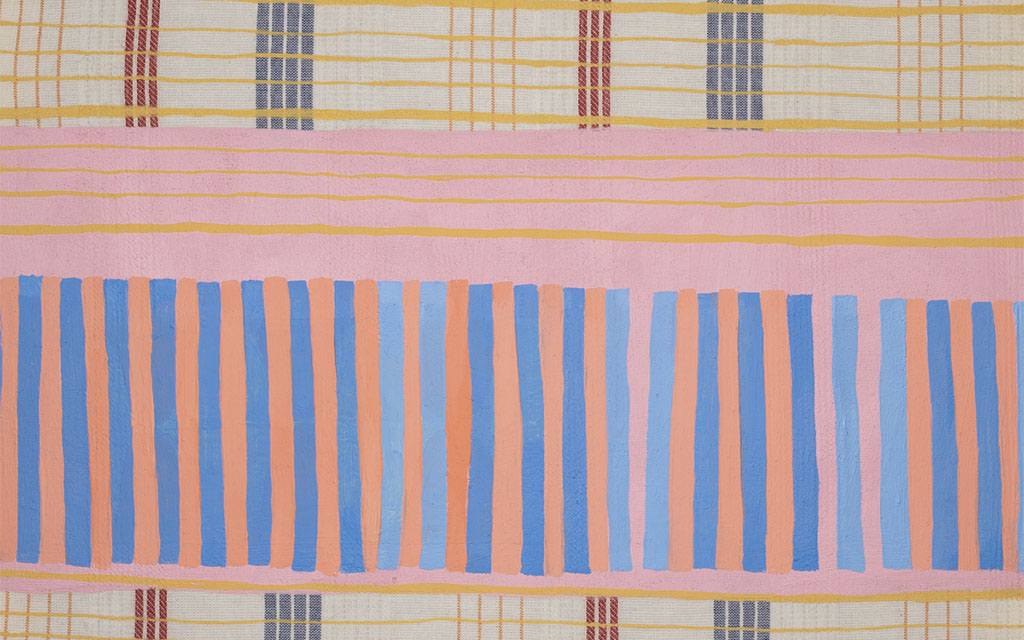Bárbara Basseto
Ai de mim, que sou romântica
Feb 9th, 2023 – Mar 10th, 2023
Galeria Luis Maluf – Peixoto Gomide, 1887
Como terei orgulho do ridículo de passar bilhetes pela porta.
Esta mesma porta hoje fecho com cuidado; altivo.
Como não repetirei, a teus pés, que o profissional esconde no índice onomástico os ladrões de quem roubei versos de amor com que te cerco.
Te cerco tanto que é impossível fazer blitz e flagrar a ladroagem.
Ana Cristina César
It is by borrowing pieces of the world that Bárbara Basseto composes, in her painting, a new world of her own. Her curious and thieving eye traverses vast fields: antique store shelves, thrift stores, haute couture clothes, art and fashion books, videos, pieces of architecture, decorative patterns of domestic objects, the incidence of light on tiles and swimming pools, the fit of curtains, towels, and rugs, playlists she listens to during the long hours she spends painting in her studio, and whatever else she finds on a walk down the street. In this exhibition, the artist’s first solo show, the various types of fabric predominate in the works and the verses of love songs in the titles.
Basseto builds – with the meticulous knowledge acquired from her training in conservation and restoration – her support. Sometimes they are canvases made with fabrics of multiple origins; at other times, they are raw linen or smooth-textured wood, whose final painting shows traces of the raw plaster used in the preparation. In any case, the matter of which the painting is made shows itself in the final image. Without illusion, but with the arousal of desire. His objects are seductive.
The starting point is not the supposedly neutral white of ordinary cotton canvas. This method produces a pleasant complication in the incorporation of materials or prints. She needs to compose with what is already composed by someone else – in fact by an industry, fashion or product design. This creates your problem to be solved, in a kind of game in which the first move is always that of your “opponent”. Not for nothing, the checkered chessboard caught her attention. The painter’s strategy of attack turns on unusual color combinations and diverse material events.
I have zeroed out the Coins of Desire is a striking example. The artist acquires a striped shirt from Dior. From the thin fabric, she stretches the canvas, not without first sewing the openings. The preparation of the surface offers rigidity, gives an embalmed character to the piece, which will never again see use, only contemplation. However, the work does not seem stiff. Basseto adds new colors and patterns to the print, in a bright and dazzling palette. Thus we can perceive her mode of action. She introduces a highly sophisticated deviation into the composition she appropriates. Basseto corrupts – I use this word because she does not follow rules, but rather a contradictory singular force, a premeditated intuition, a calculated impulse.
Basseto creates enigmas of Ana Cristina César’s strain, with appropriation, citation, and creation. The onomastic index, or at least one of them, in which Basseto hides the thieves of those who steal love verses, is her master’s research. There, she explores her relationship with pop art, especially Jasper Johns, the output of women in the Pattern and Decoration movement, and the infusion of feminine, folk, and multicultural references into the severe grid of Minimalism.
Among the references, Joyce Kozloff’s production calls my attention. The boldness of the then young American artist, when she counterposed with her own words the prescriptive adjectives, which configured rigid rules, of Ad Reinhardt, for art.
The name given to the exhibition is a verse from Mutante, a song composed by Rita Lee and Roberto de Carvalho. It refers to the procedure the artist uses in the composition of her works and their titles, her prosaic poetics. But it also refers to a spirit reworked by Bárbara Basseto, also found in Kozloff’s adjectives, which sets up a way of thinking and shaking the absolute empire of reason, of imperialism, of monotony, of purity, of universality, of sterile formalism, as if to say: “Alas, I am like that. Romantic”.
Érica Burini, curator
